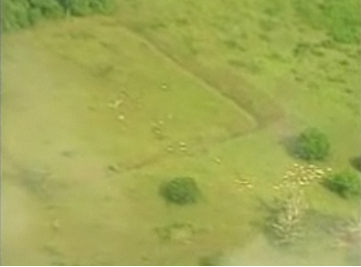Is Your Snoring Really Annoying Or Is The Person Complaining It Just A Prissy Putz?
Posted by Justin on April 13th, 2010According to a study by the Human Speech Research Laboratory: Both.
According to a study by the Human Speech Research Laboratory: Both.

Here on Weird Things, we’ve talked quite a bit about the strange history of animal (and human) experimentation for the benefit of medical science. But it would be silly to suggest that there aren’t strange trails that persist to this day.
For example, Taser International is seeking to test how harmful their products are when law enforcement uses them on subjects with elevated heart rates after methamphetamine intake. The solution? Find a bunch of sheep, jack ’em up on speed and taze them ’till they bleet.
Because of the prevalence of methamphetamine abuse worldwide, it is not uncommon for subjects in law enforcement encounters to be methamphetamine-intoxicated. Methamphetamine has been present in arrest-related death cases in which an electronic control device (ECD) was used. The primary purpose of this study was to determine the cardiac effects of an ECD in a methamphetamine intoxication model.
The results? Smaller animals saw more of an effect when zapped while high but larger sheep did not. None died.
However, this surely won’t stop someone from writing “Don’t Taze Me, Baaaaaah!” on a sandwhich board and while handing out literature in front of Taser International HQ in the next two weeks.
[io9]

Many mistaken cryptids are actually just fugly animals with a bad case of the mange. So what does that have to do with our planet’s current case of global warming driving and increase in sightings of potential Yetis, Bigfoots and Chupacabra?
LiveScience spoke to Mike Bowdenchuck, state director for Texas Wildlife Services, who explained why mysterious, hairless animals are more common in Texas and the southwest than other areas:
“Down here, animals don’t die of mange, because the temperatures are warm enough,” Bowdenchuck said. Rather, the animals live with mange.
“Mange is very common in colder areas, in fact wolves are getting it in Montana right now, and in North Dakota foxes get it,” he said, noting a big difference: “Up there it’s fatal, so you never see animals with the severe cases that we see in the southern climates, because they don’t live long enough for the mites to get that bad to cause the hair to fall off. They die of hypothermia first.”
Animals that have lost their fur are more vulnerable to the cold, so in warmer climates they live longer (and be more likely to be seen). Thus one might conclude that sightings of hairless animals will become more common as the climate warms. The extended forecast calls for more non-Bigfoot, non-Yeti, and non-chupacabra mangy monster sightings.
Why wasn’t this the poster for An Inconvenient Truth?

Western scientists have officially catalogued animals on the islands of the Phillipines for over a century and a half and yet, a 6-foot-long, gold flecked, colored lizard just happened to escape their attention. Until last summer.
Rumors of the lizard’s existence floated among biologists for the past 10 years, Brown explained.
“People had taken photographs of hunters from the resident tribespeople as they were carrying the reptiles back to their homes to feed their families in 2001,” Brown said.
In 2005, two different groups procured juvenile specimens. “However, both of those efforts didn’t collect genetic samples, so we couldn’t yet prove that it was genetically distinct and didn’t just look different,” Brown said. “Also, we wanted a full-sized adult to see how big it got in life.”
A team went on a two month expedition to track the animal down in 2009 and only found one adult male after all of their food and money had been exhausted. One possible theory while the particular lizard is scarce? Local tribesman prefer their meat to other monitor lizards.
Yummy.
What with all the earthquake news recently, it might be time to start stocking up on toads.
This from The BBC.
Common toads appear to be able to sense an impending earthquake and will flee their colony days before the seismic activity strikes.
The evidence comes from a population of toads which left their breeding colony three days before an earthquake that struck L’Aquila in Italy in 2009.
How toads sensed the quake is unclear, but most breeding pairs and males fled.
The study does not pin down exactly how the male toads knew when to skeedaddle but is anyone not in favor to all least tying a bell to every toad you see from here on out? When you hear the massive jingling, you know it is time to hit the bricks.

From The Telegraph:
The poll questioned 23,000 adults in 22 countries and found that more than 40 per cent of people from India and China believe that alien life exists with a human facade on this planet.
European respondents in the survey were more sceptical with only eight per cent of people from Belgium, Sweden and the Netherlands convinced that life from outer space exists on earth.
Men were more likely to believe in extra-terrestrial life than women with 22 per cent convinced compared to 17 per cent of women.
Although most of those who do believe in aliens were under 35 they came from all incomes and classes. There was no breakdown for British respondents.
Thanks to Dodd Vickers for passing this along.

Cryptomundo is rightly frustrated by new Chupacabra images floating around. The mangy creatures pictured all walk on four legs. Here is the one item long cheat sheet for any potential cryptid hunters: if the beast does not walk on two legs, it is not the same monster which famously made a name for itself stalking about the hills of Puerto Rico.
Just come up with a new name? Like Quad-racabra. In fact, don’t call it that until I can register the domain.

A remote controlled vehicle has discovered the deepest hydrothermal underwater vent on record 3.1 miles deep in the Cayman Trough in the Caribbean. Entitled “black smokers” the vents pump a black, iron sulfide compound into the ocean. The compound is hot enough to melt lead.
Locke is strangely unaffected by the news.

The brain trust make their case for ambivalence towards eating whales, primates and genocide in general.
Subscribe to the Weird Things podcast on iTunes
Podcast RSS feed
Episode archive
Download url:
http://www.itricks.com/upload/WeirdThings032510.mp3
[podcast]http://www.itricks.com/upload/WeirdThings032510.mp3[/podcast]
UPDATE: Thanks to all who watched the livestream and helped keep score on Twitter. For the first time in this contest’s storied history we reached a dramatic tie when Hurt Locker took home best picture. 12-12. An uneasy stalemate exists for another year…

As was tradition from whence Weird Things editor and writers Justin Robert Young and Matt Finley come from, the two have picked the Oscars against the lingering spirits of the Undead. Using random human mediums, the picks were divined without human meddling.
Enjoy!

In European legends, the bite of the werewolf involuntarily turns a hapless victim into a fuzzy-wuzzy killing machine. In American pop culture, zombies prey on the flesh of living innocents who then become skulking face gnawers themselves. In mother Russia, clock punches you. All of these contemporary Western tales portray human atrocities committed by victims of circumstance – upstanding citizens who happen to get cursed, infected or punched by clock, and then go on to act as involuntary proxies for the new and accidental darkness inside them. According to certain Navajo lore, Skinwalkers – dark witches who possess the ability to, among other things, transform into animals – are former high priests who have murdered blood relatives. In other words, it’s a story of active unholy transformation knowingly catalyzed by conscious decisions.
Remember the Algonquian story of the Wendigo – the man who engaged in cannibalism and, as a result, turned into an eternally suffering flesh-craving beast? Skinwalkers are similar in that they are men (occasionally women) who undergo a monstrous transformation by way of a  culturally forbidden act (in this case, intra-familial murder). (Granted, there are versions of the story in which Skinwalkers are simply Anakin-esque flock strayers who end up on the wrong side of the force, but I would assume that that’s equally frowned upon.) Whereas the Wendigos are forever damned to tormented lives of feral scavenging and desperate murder, Skinwalkers are powerful, deliberate and feared. Both legends, however, use the threat of once-human monstrosities to demonstrate the corruptive power of sin (“sin” meaning, in this case, culture-specific social malfeasance).
culturally forbidden act (in this case, intra-familial murder). (Granted, there are versions of the story in which Skinwalkers are simply Anakin-esque flock strayers who end up on the wrong side of the force, but I would assume that that’s equally frowned upon.) Whereas the Wendigos are forever damned to tormented lives of feral scavenging and desperate murder, Skinwalkers are powerful, deliberate and feared. Both legends, however, use the threat of once-human monstrosities to demonstrate the corruptive power of sin (“sin” meaning, in this case, culture-specific social malfeasance).
Lots of folks think that Skinwalkers are kind of like Florida’s Skunk Ape – culturally variant analogs of a familiar supernatural beasties – and regard them as Native American werewolves, but that’s totally not even close to right. Unlike werewolves, Skinwalkers transform at will, and can change into any animal of their choosing. These transformations allow Skinwalkers to travel swiftly and easily elude capture. Their shapeshifting abilities even extend to their voices, which can mimic any animal or human sound, up to and including “Sky Pilot” by human band “The Animals.” They can read thoughts, and, in some versions of the legend, even project themselves, by way of a hypnotizing stare, into their victims’ bodies, which then become mere skins in which the monsters walk (though the name “Skinwalker” actually [boringly] comes from their proclivity toward animal skin attire). As acolytes of the Witchery Way (a form of Navajo magic centered on death and corpses), Skinwalkers can use enchanted bone dust to paralyze, or even kill, their chosen victims.
Mostly, though, Skinwalkers are scary because they are self-aware, they are clever and they are malicious. They are monsters because they chose to become monsters. This Navajo legend holds individuals accountable for bringing evil into the world; werewolves and all those other stories? The excuses of desperate children pointing their guilty fingers toward the darkness of caves and the mystery of nighttime forests.
Wednesday: The boys (and girls) who cried, “Skinwalker!”

Andrew, Brian and Justin answer some listener scenarios. After revealing Brian’s deep-seated desire that the world go pantless post apocalypse, we find out how shockingly willing Brian is to switch teams and genders without actually being asked to do so. We explore the practical problems of someone who looks like Justin claiming to have a magical genii and find out about his experience in the wild frontier of Chat Roulette where he is accorded the dignity and respect he deserves for going there in the first place. We also talk about our admiration for men in leather and sometimes no leather at all wrestling and trying to kill each other.
Subscribe to the Weird Things podcast on iTunes
Podcast RSS feed
Episode archive
Download url:
http://www.itricks.com/upload/WeirdThings022310.mp3
[podcast]http://www.itricks.com/upload/WeirdThings022310.mp3[/podcast]

The trio determines what would force them to become vigilantes. Andrew describes his frightening superhero creation that involves deranged circus animals and human dismemberment. Brian tries to retcon the creation in a most horrific way.
Subscribe to the Weird Things podcast on iTunes
Podcast RSS feed
Episode archive
Download url:
http://www.itricks.com/upload/WeirdThings021210.mp3
[podcast]http://www.itricks.com/upload/WeirdThings021210.mp3[/podcast]
 Deep in the Amazon researchers are exploring the remnants of a city that dates back to 200 AD. Little is known about the inhabitants and some speculate that this could have been the source of the rumors of El Dorado. Click through for the video. Scientific American
Deep in the Amazon researchers are exploring the remnants of a city that dates back to 200 AD. Little is known about the inhabitants and some speculate that this could have been the source of the rumors of El Dorado. Click through for the video. Scientific American
 The always provocative h+ magazine surveyed the experts at the Artificial General Intelligence Conference to get a grasp of when they though machines would get really smart.
The always provocative h+ magazine surveyed the experts at the Artificial General Intelligence Conference to get a grasp of when they though machines would get really smart.
The results are very interesting:
 While the median guess is the 2020’s, some are saying we won’t see any robo super geniuses for a century or more. While we can appreciate their optimism in the delay of our demise, it feels a little bit like surveys of physicists in the 1920’s about the use of atomic energy as a weapon. That was considered a far off thing too…
While the median guess is the 2020’s, some are saying we won’t see any robo super geniuses for a century or more. While we can appreciate their optimism in the delay of our demise, it feels a little bit like surveys of physicists in the 1920’s about the use of atomic energy as a weapon. That was considered a far off thing too…